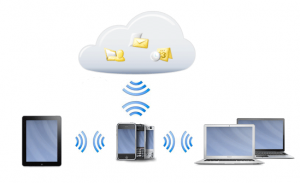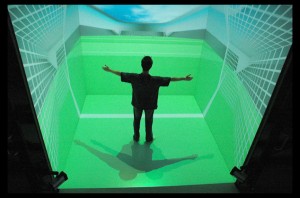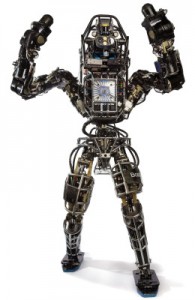May 15, 2014 – Continuing the annual list of technological advances that the editors of MIT’ Technology Review have designated as impactful to the future, today we look at numbers six through ten.
6. Microscale 3D Printing is the latest advance in additive manufacturing using a wide variety of materials from living cells to metal inks suitable for laying down integrated circuits. The latest biological experiments in 3D printing include a bionic ear that combined electronics and living cells, retinal eye tissue, and vascular tissue to create networks of blood vessels. These microscale printers have even produced lithium-ion batteries so small they can be integrated into 3D printed sensors and worn by athletes. The scale of printing is so small with structures one micrometer in diameter. Compare that to a red blood cell at 10 micrometers and you get a sense of just how tiny and precise microscale 3D has become. The image below is of 3D-printed blood vessels made from bio-compatible hydro gels. The work was done at the University of California San Diego, Jacobs School of Engineering.
7. Mobile Collaboration takes us beyond the synchronization that allowed device users to distribute and share work they were doing on multiple devices and with some applications with multiple users. Today collaboration has moved full force to the Internet where cloud-based computing is taking over. I remember when I first started using Google Docs a few years ago. I was working with a client in Australia on marketing materials for the launch of an oil spill remediation technology. We worked together on a set of common documents including spreadsheets, business plan, presentations and marketing materials. Later on I duplicated this with another client in the United States by collaborating on the development of a new franchise service delivery model. It was cool at the time but advances have made cloud services even more seamless today allowing for collaborative communication whether on a mobile device like a smartphone or tablet, a laptop or desktop system. And with the spread of publicly-funded WiFi networks within city cores and along transit lines, conversations, comments, and collaboration has never been easier. If you have yet to get into cloud computing here are a few application providers who have the tools you will need: Box, CloudOn, Dropbox, Google Drive, Microsoft OneDrive, QuickOffice and Quip.
8. Virtual Reality which the MIT list has called Oculus Rift a product of Oculus VR, the company that has recently been acquired by Facebook for $2 billion U.S. Rift is one of a number of virtual reality headsets that are entering the market. Sony Morpheus, Vuzix and Nvidia are other 3D virtual reality players in the market. Other than playing video games, to what use can you put Rift and other virtual reality headsets? For people with disabilities, confined to wheelchairs or sedentary, virtual reality opens doorways to participate in the larger world and begin to experience both normal and super normal activities. Virtual reality has application in simulators from creating the means to “walk on Mars” using the visual images collected from Martian rovers, to flying a jet aircraft or standing at the helm of a ship. Virtual reality headsets can let us revisit history and experience it as if “you are there.” Imagine being a participant in the Battle of Gettysburg, or at Cannae riding one of Hannibal’s war elephants into battle, or at Stalingrad in the epic battle between Nazi Germany and the Soviets.
9. Agile Robots are replacing those clunky biomechanical machines of the previous decade. Today we have robots that walk like humans. Companies like Boston Dynamics, recently acquired by Google, have developed two-legged robot, Atlas, seen below, a four-legged robot, Big Dog, and even a one-legged robot that jumps around pogo-stick like without losing balance. In the case of Atlas it has sensate hands that can use human tools, stereo vision, and laser range finder. At the December 2013 DARPA Robotics Challenge, another robotics company from Japan, now part of Google, achieved the highest scores. The robot named SCHAFT beat all competitors performing eight complex tasks. You can watch what we mean by agile as SCHAFT does its stuff.
10. Smart Wind and Solar Power is coming of age through the application of artificial intelligence applied to meteorological data. This is allowing wind farm and solar operators to address the issue of power intermittency from these renewable sources. What’s involved? Adding smarts to adjustable wind turbines and photovoltaic panels so that they provide performance data and power to utilities for integration to the grid. Data mining is proving to be the game changer allowing for more accurate forecasts of power generation from renewable sources. This means utilities reduce their need to keep carbon-polluting backup generators on standby for those times when wind speed and direction changes. It means the utility can adjust the turbine remotely to maximize the power it can harvest from wind. For solar photovoltaic panels the challenges are greater but solar forecasting is getting better using data from satellites and sky imagers. The next stage involves better integration of all those private rooftop solar panels that are being installed on homes and businesses so that the excess energy they produce can be integrated seamlessly into national power grids.
What’s missing from the MIT Top 10 list? Here are some other top 10s that I would have considered.
- New breakthroughs in battery and storage technologies,
- Development of Micro-grids,
- A new generation of nuclear power plants that cannot melt down and produce no nuclear waste,
- New advances in stem cell technology,
- Development of reusable rockets,
- Synthetic genomic advances,
- New technologies for mineralizing carbon to reduce atmospheric CO2,
- Blood made from stem cells,
- New low and high-tech solutions for freshwater production,
- The declining cost for DNA testing.
But who am I to challenge MIT’s picks?


























